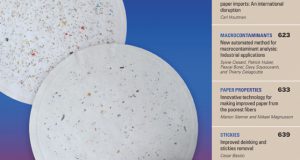VACUUM SYSTEMS
DOUG SWEET, P.E.
When creating a long list of best practices relative to paper machine vacuum systems, they seem to fall into two classifications: Process and Management. We presented process best practices in the Sep/Oct issue of Paper 360°. Here we will look at management best practices.
Considering the essential requirement for reliable and controllable vacuum for all paper machine applications (flatboxes, couch, pressing, sheet transfer, and felt dewatering and conditioning) there are many items impacting the system that are not process-related. Management best practices are related to personnel, mill procedures and culture, and employee expectations. The best processes may not be well-managed, while the best management may provide superior operation of older processes.
TRAINING AND GENERAL
VACUUM SYSTEM KNOWLEDGE
Although we are in a technology boom with “smart” equipment and computer control, paper mills can’t run themselves. People are still working hard to keep processes within desired operating ranges and when all isn’t perfect, they are hopefully cleaning up and washing down the machine to get ready for thread-up following a sheet break. Often, operators with 25 years of experience are not able to provide basic information or do not understand cause and effect within these systems. Although training should be ongoing and applied to all processes, here we will only discuss specific vacuum systems needs.
 Vacuum systems training should begin with the basics of vacuum measurement. This should include understanding the difference between inches of water and inches of mercury. Orders of magnitude need to be explained to allow operators to know that full vacuum of about 30 in. Hg is only equal to 15 psi. Often, operators will express vacuum in pounds of vacuum.
Vacuum systems training should begin with the basics of vacuum measurement. This should include understanding the difference between inches of water and inches of mercury. Orders of magnitude need to be explained to allow operators to know that full vacuum of about 30 in. Hg is only equal to 15 psi. Often, operators will express vacuum in pounds of vacuum.
A favorite example of a lack of understanding of vacuum measurement was with a DCS display showing Deculator vacuum of 31.5 in. Hg (see Fig. 1.) No one in the control room seemed to be concerned that this was an impossible value and that ideal vacuum was about 26 in. Hg.
Vacuum measurement is usually found to be as poorly executed as seal water control. Local gauges are not maintained and procedures do not exist to check and calibrate transmitters. Other issues include incorrect gauge types (vacuum vs. compound) and physical locations that are difficult or unsafe to maintain.
Examples of training needs were described in Part 1 and included discussions about table vacuum, seal water control, cooling towers, and vacuum separator systems. Best practices for operator training include the following:
• Review and update vacuum system training and include understanding of vacuum measurement and subsystem operations (separator/pump systems, seal water, and cooling towers)
• Review vacuum gauge applications and eliminate use of compound gauges—replace inoperable gauges
• Develop improved operator inspection efforts in daily rounds
HOUSEKEEPING
Almost nothing in a mill is less technical than housekeeping. However, there are many examples illustrating how a clean mill generally operates better and more safely. This is truly a management and mill culture issue.
I first published my “Earplug Theory” about 10 years ago. It suggests a correlation between paper mill operating efficiencies and the number of discarded earplugs between the paper machine and parking lot:
More earplugs = poor housekeeping = lower efficiencies.
 This theory applies to the vacuum system because generally the vacuum pumps are in the basement and/or outside the mill. Therefore, vacuum pumps are out of the normal line of sight for operators
This theory applies to the vacuum system because generally the vacuum pumps are in the basement and/or outside the mill. Therefore, vacuum pumps are out of the normal line of sight for operators  and likely never in the path of a mill tour group. Since vacuum pumps don’t usually require a lot of daily attention, they seem to be forgotten until serious problems arise. Housekeeping and management supporting clean mill environments usually result in more frequent interaction with systems not on the operating floor.
and likely never in the path of a mill tour group. Since vacuum pumps don’t usually require a lot of daily attention, they seem to be forgotten until serious problems arise. Housekeeping and management supporting clean mill environments usually result in more frequent interaction with systems not on the operating floor.
Many vacuum studies have resulted in findings of basic issues that have been ignored (see Fig. 2.) This can include vacuum and water leaks, bearing failures due to excess or lack of lubrication, inability to identify critical items due to excess grease slinging off the pump shafts, flooded areas due to plugged drains, and lack of lighting to support basic inspections. Mill personnel often end up apologizing when some of these relatively simple findings are discovered once some attention is given to the equipment and system.
Housekeeping Best Practices include:
• Buy more trash cans, empty regularly
• Clean excess grease following routine lubrication
• Clean grease and slime from handrails for safe use
• Consider it unacceptable to clutter floors and catwalks
• Repair/replace broken lighting—cleaner, better lighting allows better audits
EQUIPMENT IDENTIFICATION
Accurate labeling of process piping and equipment is essential. Physical identification of piping and equipment with easy-to-read labeling is necessary (Fig. 3.) Also, process drawings and DCS schematics need to show the same information. However, as mills age and processes are modified, proper labeling is often not completed with the project.
There are a few basic best practices related to equipment labeling and documents:
• Labeling vacuum pumps, motors and auxiliary equipment
• Labeling valves and blanks within the vacuum piping network and accompanying this with information about valve/blank positions (normally closed or normally open)
• Process drawings must be current to show accurate information
• DCS displays that accurately show processes
• Use of bar charts in DCS displays besides just raw data can provide quick identification of issues
VACUUM PUMP
MAINTENANCE AND REPAIRS
Many people are involved in this effort, including lubrication and vibration techs, maintenance superintendents, maintenance planners, and purchasing managers. Essential in-house maintenance includes routine bearing lubrication and vibration measurement and trending. Vacuum pump condition/performance can be determined by several methods, including: performance testing (easiest with smaller pumps), fiberscope inspections of pump internals, and measurement and trending of system vacuum levels and operating horsepower.
 This last item, trending operating data, is seldom done. Many mills will spend between US$50,000 – $100,000 for removal, rebuilding, shipping, and reinstalling large vacuum pumps that were in good condition. Errors can exist in performance test results and analysis of fiberscope inspections. Meanwhile, no one in the mill has questioned why a pump reported at 50-60 percent of new performance had little or no change in vacuum or horsepower before or after the repair.
This last item, trending operating data, is seldom done. Many mills will spend between US$50,000 – $100,000 for removal, rebuilding, shipping, and reinstalling large vacuum pumps that were in good condition. Errors can exist in performance test results and analysis of fiberscope inspections. Meanwhile, no one in the mill has questioned why a pump reported at 50-60 percent of new performance had little or no change in vacuum or horsepower before or after the repair.
Some mills experience frequent bearing failures and are comfortable with bearing life of 5-10 years. They may not realize most liquid ring pumps are equipped with robust bearing designs that often have a design life of 15 to 20 years. Repetitive and high frequency bearing failures are often due to inaccurate machining and repair issues. Other causes of bearing failures are due to poor lubrication practices (lack of, or excessive), misalignment, incorrect coupling selection, and corrosion and deterioration of bases and foundations.
As mentioned, vacuum pump bearings have long design lives. Where seal water quality is very good it is not surprising to find every pump on one paper machine to be in almost new condition after 25 years. At that point it is wise to begin a bearing replacement effort.
Vacuum pump manufacturers have OEM repair facilities or authorized service centers. There are several other machine shops that repair vacuum pumps only, and many more offering to rebuild whatever has recently broken. The OEM facilities will use original and remanufactured parts and have manufacturing drawings. Similar to rebuilds of fans and centrifugal pumps, other shops will be reverse engineering components and may have acquired some original drawings. It is worthwhile to visit any of these facilities before choosing where a vacuum pump is to be rebuilt. Request a disassembly report, including photos. Visiting the shop during disassembly is a good choice to get a better understanding of wear and failure issues. Consider testing the pump for capacity and horsepower following the rebuild (Fig. 4.)
Once the pump is reinstalled, determine if the bearings were adequately lubricated during the rebuild; if so, don’t add more grease. A few mills are still relying on oil lubrication, and this is easier to determine. After installation, alignment, and startup, pay attention to adjusting packing during the first few weeks. Sometimes this is ignored and finally gets attention when the shaft seals are seriously leaking water, which can get into the bearings.
Maintenance and repair of vacuum pumps should include these best practices:
1. Understand long bearing design lives, and investigate repeated failures of specific pump bearings or random failures as frequently as within five years of replacement.
2. Develop good procedures for bearing lubrication amounts and frequency. Resist excessive lubrication.
3. Develop good procedures for monitoring bearing vibration and temperature.
4. Review procedures for pump alignment.
5. Inspect pump bases and foundations for deterioration. These can be more than 50 years old.
6. Consider performance testing rebuilt pumps.
7. Either performance test or fiberscope vacuum pumps at least every two years. Frequency can be longer depending on specific mill experiences. Compare motor loads and vacuum levels to performance data when evaluating if a pump needs to be overhauled.
8. Analyze time between failures and compare entire repair cost (overhaul, removal, reinstallation, shipping) when evaluating pump repair choices.
9. Choose repair facilities after some research, comparison and even site visits.
Considering the importance of the vacuum system, there are several items impacting performance besides piping, valves, and motors. Examining training, housekeeping, equipment labeling and identification, and maintenance procedures will have positive effects on troubleshooting, machine efficiency, and maintenance costs. Application of these best practices will usually require little cost. Benefits will be measurable and can be significant.
Doug Sweet, P.E. is principal of Doug Sweet & Associates, Inc., and has more than 40 years experience with vacuum system optimization in mills around the world. Contact him at [email protected] and visit www.dougsweet.net
Fig. 1: Does this number bother anyone? No one in the control room seemed to be concerned that 31.5” Hg is an impossible value.
Fig. 2: A 10 in. diameter vacuum line with failed rubber boot. Leak caused 5 in. Hg of vacuum reduction. Duct tape indicates previous attempt to fix.
Fig. 3: An example of good labeling.
Fig. 4: Two fabricated stainless steel rotors for the same pump model. The right is OEM; the left side tested at 65 percent of new performance.
 Paper 360
Paper 360


